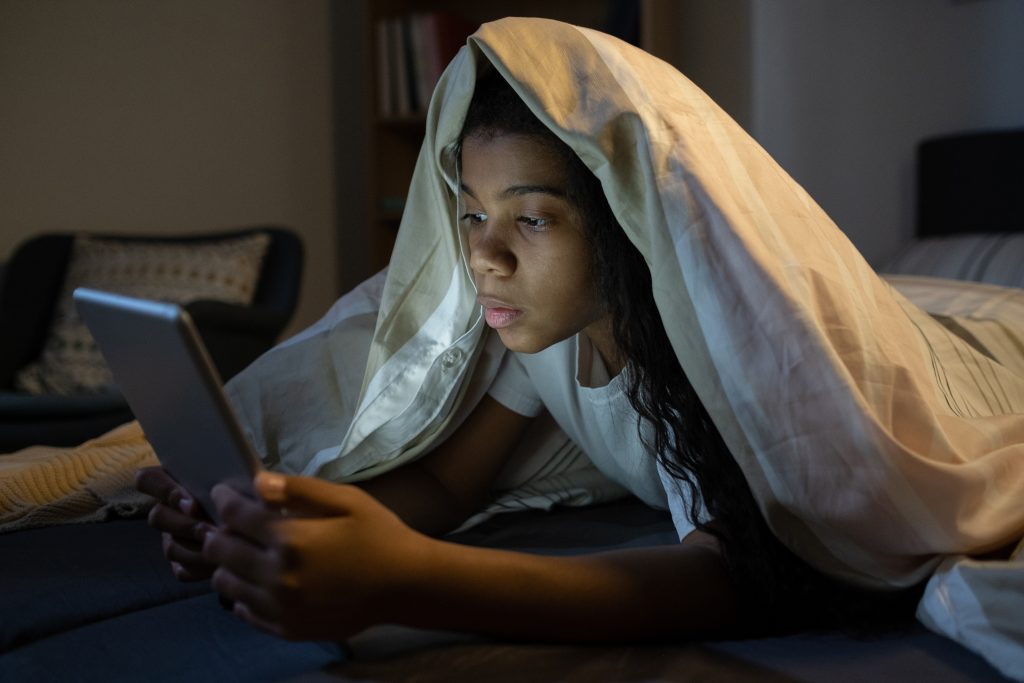Have you ever noticed how your mood shifts after hours of staring at screens? Perhaps you’ve experienced that familiar tension headache creeping in during a long day of video calls, or found yourself feeling unusually irritable after an extended session of digital work. You’re not alone – recent studies indicate that Australians spend an average of 9.9 hours daily on screens, making digital eye strain a significant modern health consideration.
The Hidden Impact of Our Digital Lives
Our relationship with screens has transformed dramatically over the past decade. While technology has brought unprecedented convenience and connectivity, it’s also introduced new challenges to our wellbeing. Understanding these challenges is the first step toward maintaining better health in our increasingly digital world.
The impact of prolonged screen time extends beyond just tired eyes. Healthcare professionals are increasingly observing connections between digital habits and overall wellbeing, including:
- Changes in sleep patterns and quality
- Increased frequency of headaches
- Neck and shoulder tension
- Mood fluctuations
- Difficulty concentrating
- General fatigue
- Altered stress responses

Understanding Digital Eye Strain
Digital eye strain, also known as computer vision syndrome, develops when our eyes work overtime to process digital information. Unlike reading printed materials, screens emit light, refresh constantly, and often display flickering images – all of which can challenge our visual system in unique ways.
Common indicators that you might be experiencing digital eye strain include:
- Blurred or unfocused vision after screen use
- Dry or irritated eyes
- Difficulty focusing on detailed tasks
- Increased sensitivity to light
- Regular headaches during or after screen time
- Neck and shoulder discomfort
- General eye fatigue
The Mental Wellbeing Connection
The relationship between digital eye strain and mental wellbeing is more complex than many realise. Research suggests that prolonged screen time can affect our mental state in several ways:

1. Stress Response
Extended screen time can trigger physical stress responses, including:
- Elevated muscle tension
- Increased cortisol levels
- Disrupted breathing patterns
- Heightened nervous system activity
2. Sleep Patterns
Screen exposure can affect our sleep-wake cycle by:
- Disrupting natural melatonin production
- Altering circadian rhythms
- Making it harder to wind down
- Affecting sleep quality
3. Social Interaction
Digital communication can impact our social wellbeing through:
- Reduced face-to-face interaction
- Changed communication patterns
- Altered non-verbal understanding
- Modified social connection quality
Professional Healthcare Insights
Healthcare professionals often observe that managing digital eye strain requires a comprehensive approach. When discussing screen-related health concerns with AHPRA-registered doctors, consider mentioning:
- Your daily screen time patterns
- Any recurring physical symptoms
- Changes in sleep quality
- Mood fluctuations
- Energy level variations
- Current coping strategies
Practical Strategies for Digital Wellbeing
1. Optimise Your Digital Environment
Create a screen-friendly workspace by implementing these evidence-based practices:
- Position screens at arm’s length
- Align monitors slightly below eye level
- Ensure proper lighting to reduce glare
- Use ergonomic furniture
- Consider blue light filters
- Maintain good posture
2. Implement Protective Practices
The 20-20-20 rule is a widely recognised strategy:
- Every 20 minutes
- Look at something 20 feet (6 metres) away
- For at least 20 seconds
3. Create Digital Boundaries
Establish healthy limits by:
- Setting specific work hours
- Creating screen-free zones
- Implementing digital sunset routines
- Using screen time tracking apps
- Taking regular breaks

Building Long-term Digital Wellness
Morning Routine
Start your day with eye-friendly practices:
- Delay initial screen exposure
- Get natural light exposure
- Practice distance focusing
- Do gentle stretching
- Stay hydrated
Workday Strategy
Maintain eye health during work:
- Take regular screen breaks
- Practice proper ergonomics
- Include movement intervals
- Use breathing exercises
- Stay hydrated throughout the day
Evening Wind-Down
Create a digital sunset routine:
- Reduce screen brightness gradually
- Enable night mode settings
- Plan screen-free activities
- Practice relaxation techniques
- Create a calm sleep environment
When to Consider Professional Support
While many people can manage digital eye strain through self-care strategies, there may be times when professional healthcare guidance becomes beneficial. Consider speaking with an AHPRA-registered healthcare professional if you experience:
- Persistent headaches
- Ongoing sleep difficulties
- Regular neck and shoulder pain
- Sustained mood changes
- Consistent difficulty focusing
- Recurring eye discomfort
Professional healthcare providers can offer:
- Comprehensive health assessments
- Personalised management strategies
- Professional guidance
- Regular monitoring when needed
- Preventive health recommendations

Technology and Wellbeing: Finding Balance
Creating a sustainable relationship with technology involves several key aspects:
1. Mindful Digital Usage
- Set clear intentions for screen activities
- Use technology purposefully
- Practice regular digital detox periods
- Monitor digital habit patterns
- Adjust based on wellbeing impact
2. Physical Environment
- Create ergonomic workspaces
- Ensure proper lighting
- Maintain clean screens
- Use appropriate screen filters
- Consider standing desk options
3. Emotional Awareness
- Notice mood changes with screen use
- Practice stress-monitoring
- Maintain social connections
- Balance online and offline activities
- Prioritise face-to-face interactions
Looking Forward: Sustainable Digital Health
As our reliance on digital devices continues to grow, maintaining digital wellbeing becomes increasingly important. Consider implementing these sustainable practices:
1. Regular Wellbeing Check-ins
Monitor your digital wellness by tracking:
- Daily screen time patterns
- Sleep quality
- Physical comfort levels
- Emotional responses
- Work-life balance
2. Adaptive Strategies
Stay flexible by:
- Updating practices as needs change
- Incorporating new research findings
- Adjusting to changing work patterns
- Modifying environment as needed
- Reviewing and revising boundaries

Taking Action for Better Digital Wellbeing
Start with these manageable steps:
- Implement the 20-20-20 rule tomorrow
- Set up one screen-free zone in your home
- Create a simple digital sunset routine
- Schedule regular movement breaks
- Monitor your response to these changes
If digital eye strain is significantly affecting your well-being, consider speaking with an AHPRA-registered healthcare professional. At GreenMed Care, our healthcare team understands the challenges of modern digital life and can provide professional guidance through convenient telehealth consultations.
Professional Support When You Need It
Our AHPRA-registered healthcare professionals are available to discuss your concerns about digital eye strain and its impact on your wellbeing. Through secure telehealth consultations, we can:
- Assess your current situation
- Discuss appropriate management strategies
- Provide personalised guidance
- Offer ongoing support when needed
Remember, managing digital eye strain isn’t about eliminating screen time – it’s about creating sustainable habits that support both your professional needs and your overall wellbeing. Whether you’re looking to prevent digital eye strain or seeking support for existing concerns, professional healthcare guidance can help you develop strategies that work for your lifestyle.
Book a telehealth consultation with our AHPRA-registered healthcare professionals to discuss your digital wellbeing needs and explore appropriate support options.
